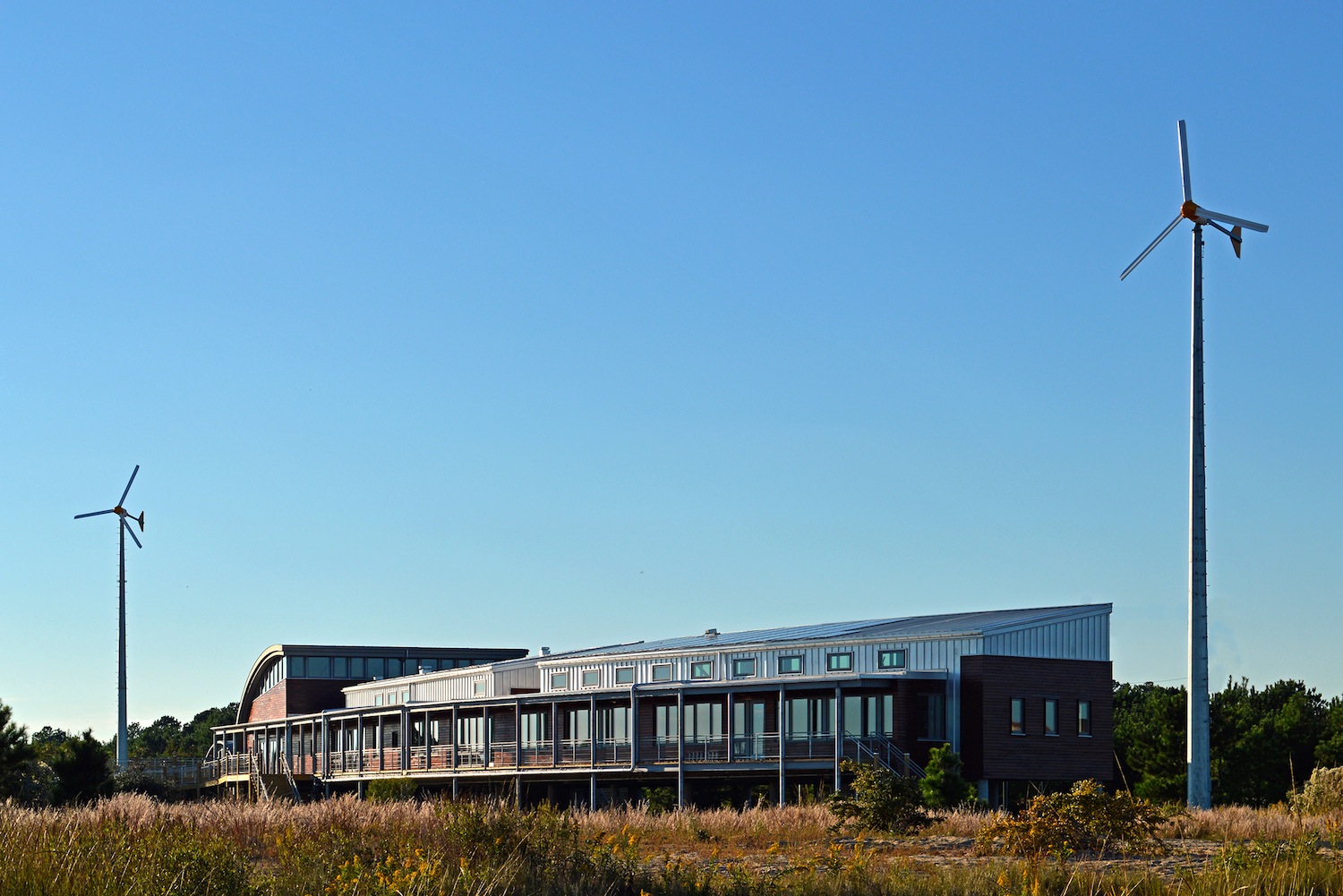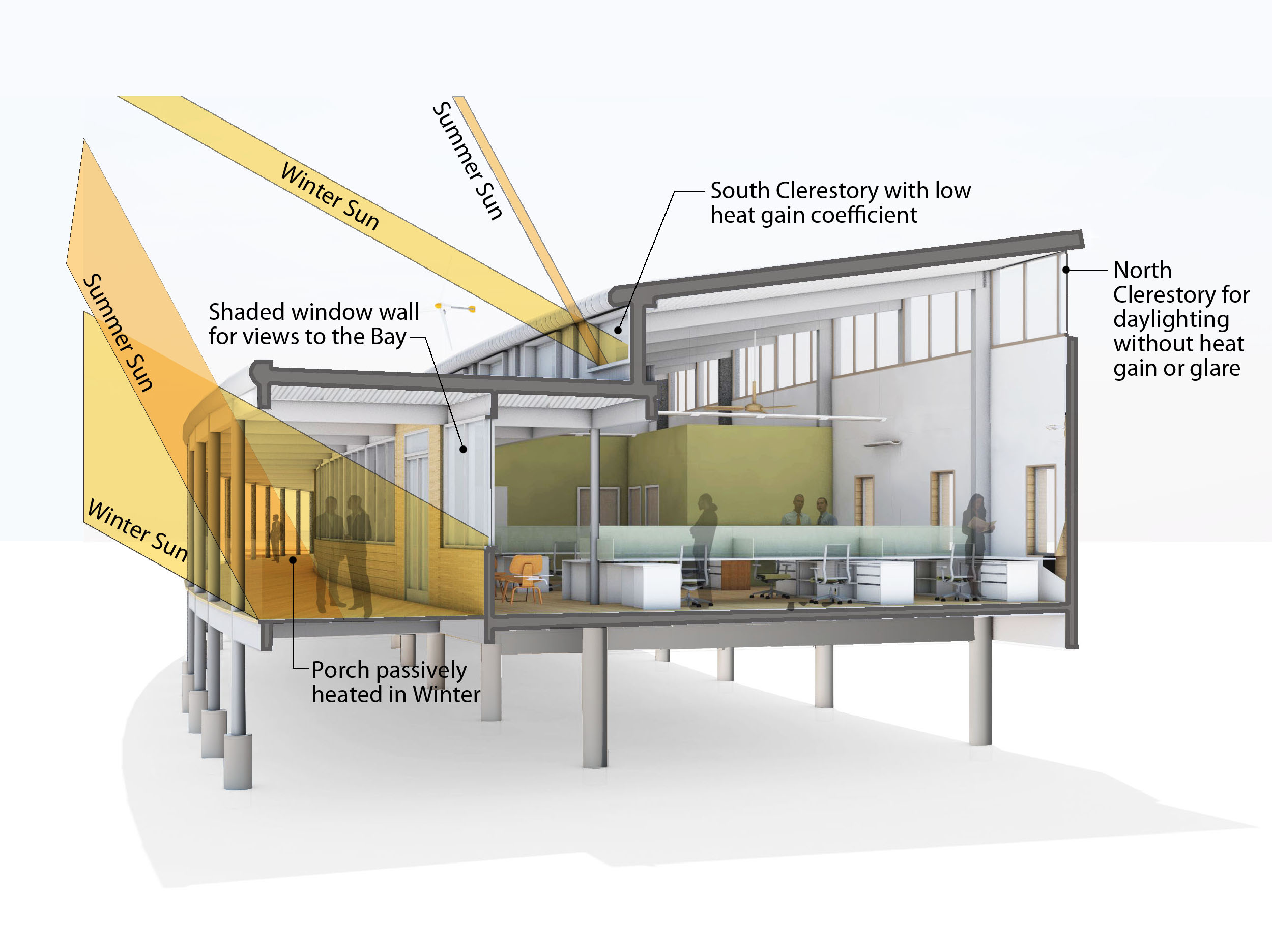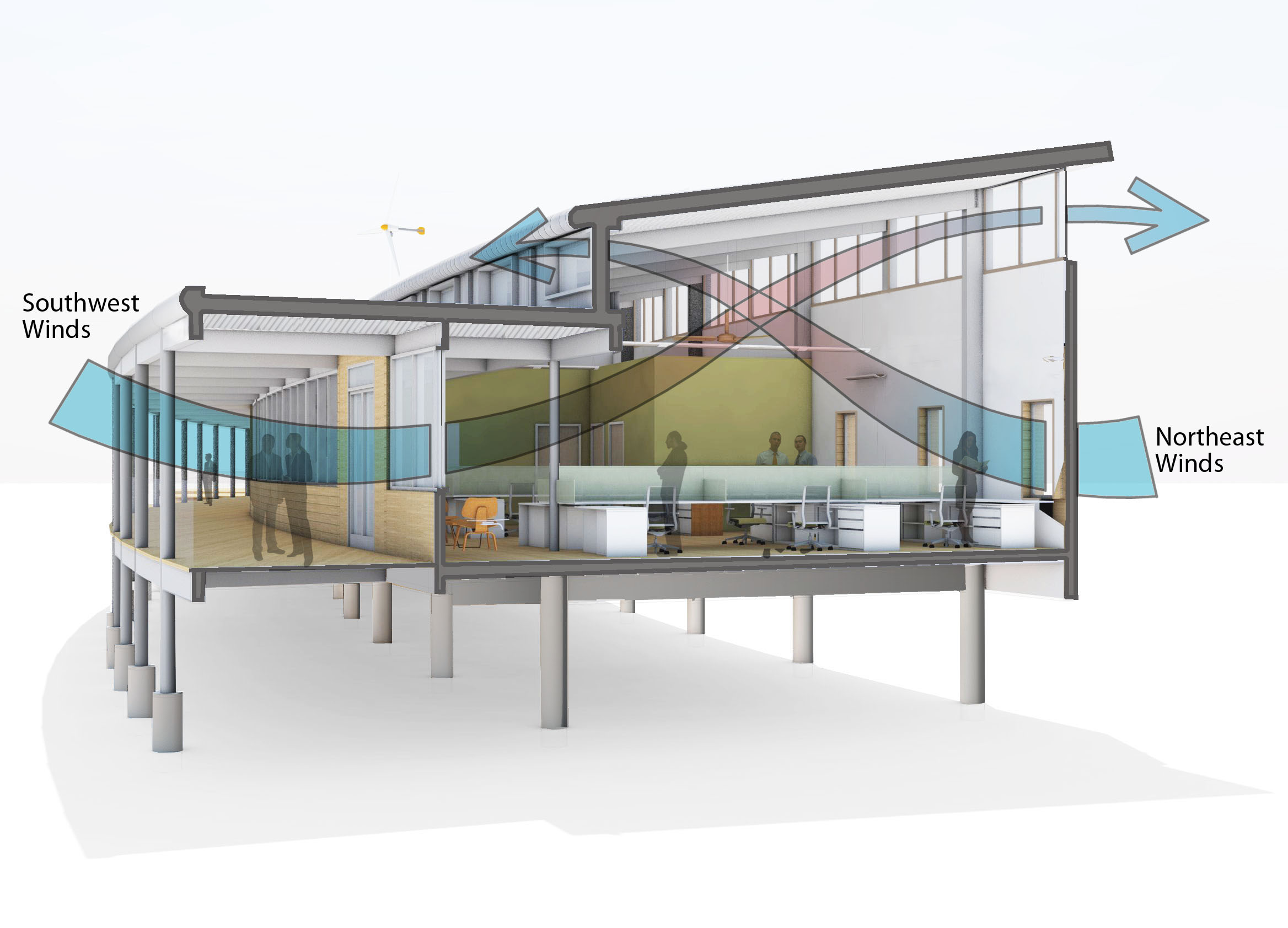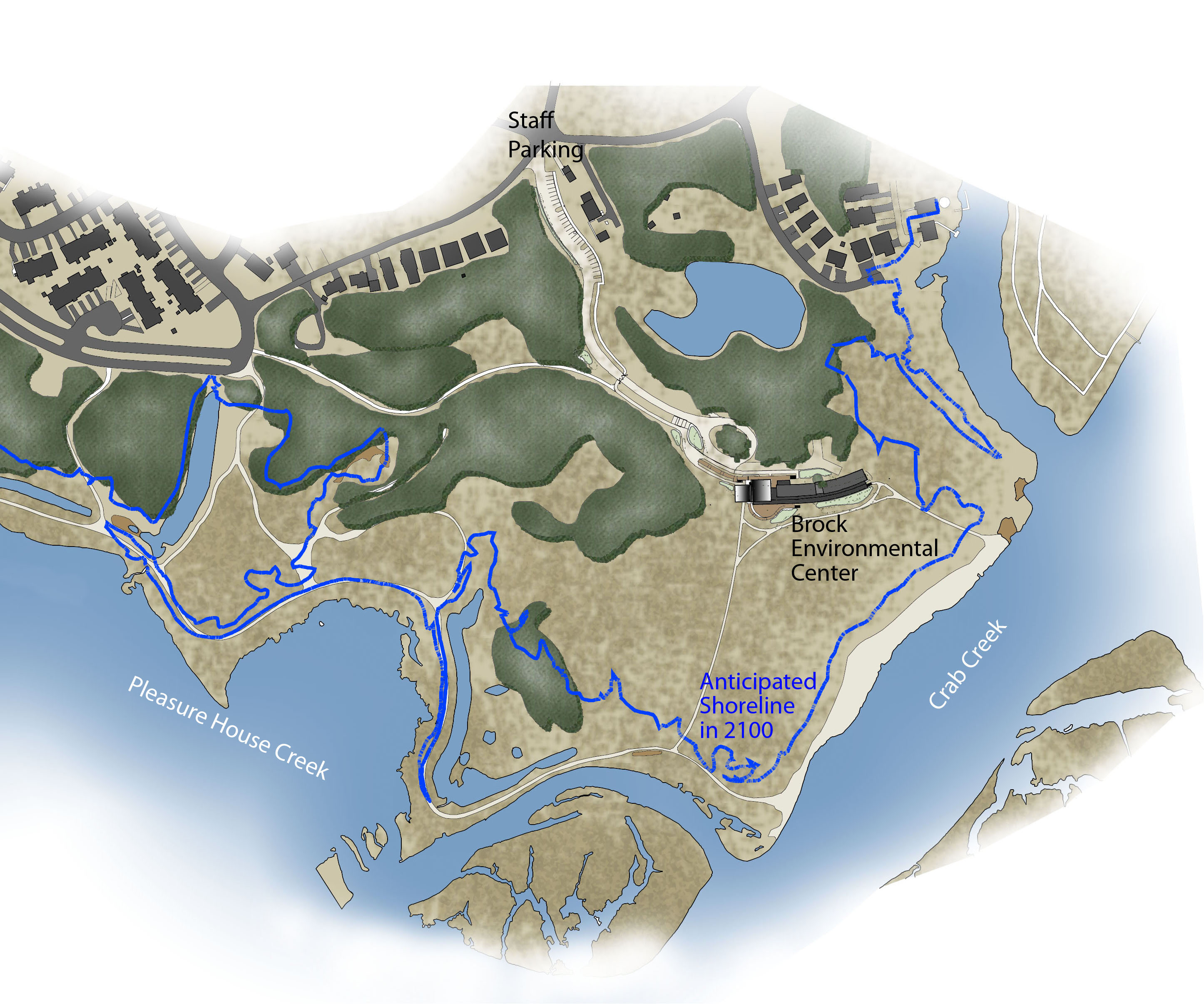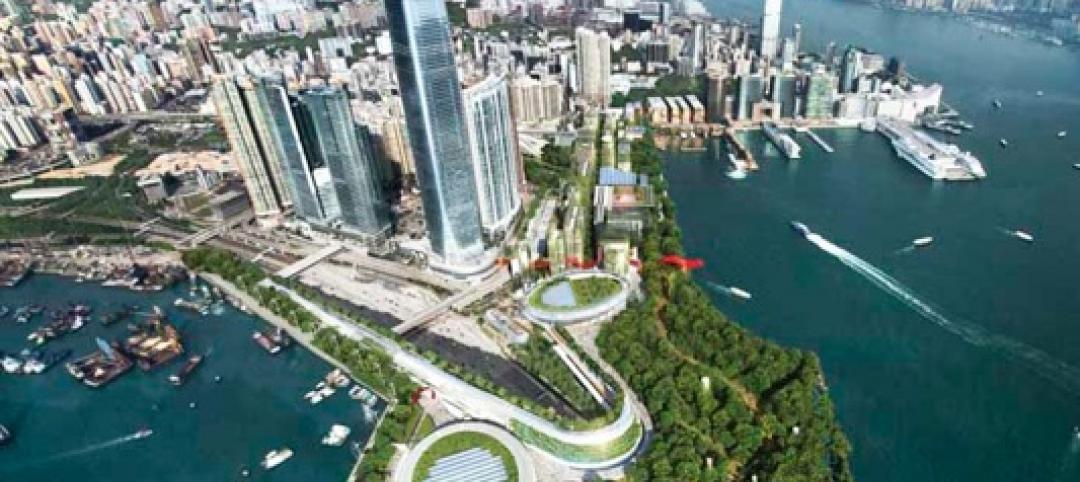The Chesapeake Bay Foundation’s (CBF) Brock Environmental Center reached construction completion today in Virginia Beach, Va. Designed by SmithGroupJJR and constructed by Hourigan Construction, the Center is an international model for energy and water efficiency and climate change resiliency.
The 10,000-sf, one-story building will serve as the hub for CBF’s Hampton Road office and support its Chesapeake Bay education, outreach, advocacy and restoration initiatives. In addition to offices for CBF and partner groups, the Center provides meeting rooms and exhibit display areas, and an 80-seat conference room designed to express CBF’s mission to defend one of the nation’s most valuable and threatened natural resources—the Chesapeake Bay.
Every aspect of the Center—location, materials, utilities, operation and use—meets the strictest environmental standards. “With the Brock Environmental Center, CBF is raising the bar for sustainability,” said Greg Mella, FAIA, LEED AP, SmithGroupJJR project manager and design architect.
“The Brock Center is a model for environmental awareness in our industry,” commented Mark Hourigan, president of Hourigan Construction.
The Center is targeting LEED Platinum designation and also strives to meet the strict standards of the Living Building Challenge (LBC), a green building certification program promulgated by the International Living Future Institute that defines the most advanced measure of sustainability in the built environment possible today. LBC standards require the facility to have “net zero” impact on the environment. The Brock Environmental Center would become the first building in Virginia to earn LBC certification; to-date, only five projects in the world have achieved Full Certification through the Living Building Challenge.
Designed for Resiliency on a Preserved Site
Completion of the Center concludes a successful community effort to save Virginia Beach’s 118-acre Pleasure House Point tract from development. As recently as 2008, developers intended to build more than 1,100 new high-rise condos and townhouses on the property. The collapse of the housing market in 2009, however, led to bank foreclosure of the property.
A community partnership with CBF, the City of Virginia Beach and the Trust for Public Land purchased the land from the bank in 2012, preserving it for open space and environmental education. The new Center, the only major structure on the entire 118 acres, takes up only one-half acre of CBF’s 10-acre parcel. Preserving the local ecology was paramount upon development of the site, which includes a boat pier with floating dock and an open-air education pavilion.
The project is situated on a coastal site to facilitate the client’s outdoor education program. The design anticipated the onset of sea-level rise and hurricanes: the building is set back 200 feet from the shore and sits on pylons 14 feet above sea level. Even the building’s structural steel system was designed to be capable of resisting 120-mph hurricane force winds.
“We had the opportunity to push the envelope on innovative and creative methods,” said Chris Brandt, executive vice president of Hourigan Construction. “There were so many certification levels that needed to be met that it was a job in itself to keep track of them all.”
Targeting Net-Zero Water, Energy and Waste
SmithGroupJJR designed the building to use very little energy by incorporating a series of aggressive, energy-saving features such as natural ventilation, natural daylighting and sunshading, highly efficient geo-thermal heating and cooling, and super insulation.
The Center is on track to be the first commercial-scale building in the continental U.S. to earn net-zero water status. A rainwater collection system will store rainwater in tanks under the building and then filter it for hand-washing and drinking through a state-of-the-art water filtration system licensed by the State of Virginia’s Office of Drinking Water. The Center features waterless, composting toilets, and all grey water (wastewater generated from sinks and showers) will be channeled through a wetland constructed of native plants where natural processes will clean and return it to the underground aquifer.
Net-zero energy status will be realized as the building generates its own electricity via solar and wind-powered renewable energy. The Center’s array of 38.8 kW rooftop photovoltaic panels will produce 60 percent of the building’s energy needs by converting the sun’s energy to electricity. Two small, 10-kilowatt wind turbines, 80’ tall, will contribute the remaining 40 percent of the building’s energy needs. Using only as much energy as it generates over the course of a year will enable the Center to earn net-zero energy certification. Surplus energy will be returned to the power grid.
Materials: Natural and Salvaged, “Red List” Chemicals Avoided
For the Center, construction materials were selected for their natural and simple properties. Preference was given to materials that are bio-based instead of those heavily processed, complex, synthetic and chemical-based. In specifying building materials, the design and construction team took special care to not use any materials on the International Living Future Institute’s “Red List,” which identifies chemicals and materials considered harmful to humans and the environment.
As a LBC requirement, recycled, salvaged and reclaimed materials were used extensively throughout the project. Examples include cypress siding from reclaimed sinker logs, wood flooring made from old fence posts and barn siding, interior wood trim from salvaged high school bleachers, and mirrors and toilet accessories from a local hospital demolition. The Rainwater Cistern and reception desk millwork were constructed from salvaged pickle barrels, and cabinet hardware consists of used champagne corks.
Hourigan Construction used cutting-edge building techniques in constructing the Center in order to minimize environmental impacts. In addition to using toxin-free building materials, sustainable measures used during construction included solar-powered tools and paperless construction documents. Normal construction equipment noise was reduced by the use of filters and baffles on the exhaust systems of all operating equipment, and slings or, in effect, construction equipment diapers were used so no equipment discharge would be deposited on the building site.
Even Hourigan’s on-site construction offices used less energy and water than normal systems. Instead of piping in treated water from the public grid, a deep fresh water well was installed to utilize existing water for construction use.
CBF: Continuing to Push the Boundaries of Sustainability
The Chesapeake Bay Foundation will occupy the building by the end of 2014. Prior, building occupants will be trained in the day-to-day operations and measurements of the renewable technologies. A 12-month measurement period is planned to commence in early 2015 and continue until early 2016. LBC certification is targeted for mid-2016.
The ultra-green Brock Environmental Center is the latest CBF initiative to push the boundaries of sustainability. The Foundation started with the 2000 completion of its Annapolis, Maryland headquarters building, the Philip Merrill Environmental Center, also designed by SmithGroupJJR. In 2001, the Merrill Center became the world’s first LEED Platinum building and was soon-after recognized as an international model of sustainability.
“What LEED Platinum was when we were designing the Philip Merrill Environmental Center, the Living Building Challenge is now,” said SmithGroupJJR’s Mella, who is based at the firm’s Washington, DC office. “Back then, we were designing to do less harm to the environment. Now, we’ve designed a building that could actually improve the environment,” he added.
The Brock Environmental Center is named in honor of Virginia Beach philanthropists Joan and Macon Brock in recognition of their $3.5 million donation toward the $21 million capital campaign to build, operate and endow a new Hampton Roads environmental center.
Joining SmithGroupJJR (architect and MEP engineer) and Hourigan Construction (general contractor) were WPL Site Design, Virginia Beach, civil engineer and landscape architect; and A+F Engineers, Washington, DC, for structural engineering. Skanska, New York, NY, served as the owner’s representative.
SmithGroupJJR (www.smithgroupjjr.com) is a recognized, integrated design firm with 800 employees in 10 offices. With more than 100 LEED certified projects and 343 LEED professionals, SmithGroupJJR is a national leader in sustainable design.
Hourigan Construction (www.houriganconstruction.com) is a full-service construction management company with operations throughout the Southeast U.S. The firm has constructed multiple projects in the Hampton Roads region and across Virginia.
Related Stories
| Mar 16, 2011
AIA offers assistance to Japan's Architects, U.S. agencies coordinating disaster relief
“Our hearts go out to the people of Japan as a result of this horrific earthquake and tsunami,” said Clark Manus, FAIA, 2011 President of the AIA. “We are in contact with our colleagues at AIA Japan and the Japan Institute of Architects to offer not only our condolences but our profession's technical and professional expertise when the initiative begins focusing on rebuilding."
| Mar 16, 2011
Are you working on a fantastic residence hall project? Want to tell us about it?
The feature story for the May 2011 issue of Building Design+Construction will focus on new trends in university residence hall design and construction, and we’re looking for great projects to report on and experts to interview. Projects can involve new construction or remodeling/reconstruction work, and can be recently completed, currently under construction, or still on the boards.
| Mar 16, 2011
Foster + Partners to design carbon-neutral urban park for West Kowloon Cultural District in Hong Kong
Foster + Partners has been selected by the board of the West Kowloon Cultural District Authority to design a massive 56-acre urban park on a reclaimed harbor-front site in Hong Kong. Designed as a carbon-neutral development, “City Park” will seamlessly blend into existing streets while creating large expanses of green space and seventeen new cultural venues.
| Mar 15, 2011
What Starbucks taught us about redesigning college campuses
Equating education with a cup of coffee might seem like a stretch, but your choice of college, much like your choice of coffee, says something about the ability of a brand to transform your day. When Perkins + Will was offered the chance to help re-think the learning spaces of Miami Dade College, we started by thinking about how our choice of morning coffee has changed over the years, and how we could apply those lessons to education.
| Mar 15, 2011
What will the architecture profession look like in 2025?
The global economy and the economic recession have greatly affected architecture firms' business practices. A Building Futures survey from the Royal Institute of British Architects looks at how these factors will have transformed the profession and offers a glimpse of future trends. Among the survey's suggestions: not only will architecture firms have to focus on a financial and business approach rather than predominantly design-led offices, but also company names are predicted to drop ‘architect’ altogether.
| Mar 15, 2011
Passive Strategies for Building Healthy Schools, An AIA/CES Discovery Course
With the downturn in the economy and the crash in residential property values, school districts across the country that depend primarily on property tax revenue are struggling to make ends meet, while fulfilling the demand for classrooms and other facilities.
| Mar 14, 2011
Renowned sustainable architect Charles D. Knight to lead Cannon Design’s Phoenix office
Cannon Design is pleased to announce that Charles D. Knight, AIA, CID, LEED AP, has joined the firm as principal. Knight will serve as the leader of the Phoenix office with a focus on advancing the firm’s healthcare practice. Knight brings over 25 years of experience and is an internationally recognized architect who has won numerous awards for his unique contributions to the sustainable and humanistic design of healthcare facilities.
| Mar 11, 2011
University of Oregon scores with new $227 million basketball arena
The University of Oregon’s Matthew Knight Arena opened January 13 with a men’s basketball game against USC where the Ducks beat the Trojans, 68-62. The $227 million arena, which replaces the school’s 84-year-old McArthur Court, has a seating bowl pitched at 36 degrees to replicate the close-to-the-action feel of the smaller arena it replaced, although this new one accommodates 12,364 fans.
| Mar 11, 2011
Temporary modular building at Harvard targets sustainability
Anderson Anderson Architecture of San Francisco designed the Harvard Yard childcare facility, a modular building manufactured by Triumph Modular of Littleton, Mass., that was installed at Harvard University. The 5,700-sf facility will remain on the university’s Cambridge, Mass., campus for 18 months while the Harvard Yard Child Care Center and the Oxford Street Daycare Coop are being renovated.
| Mar 11, 2011
Holiday Inn reworked for Downtown Disney Resort
The Orlando, Fla., office of VOA Associates completed a comprehensive interior and exterior renovation of the 14-story Holiday Inn in the Downtown Disney Resort in Lake Buena Vista, Fla. The $25 million project involved rehabbing the hotel’s 332 guest rooms, atrium, swimming pool, restaurant, fitness center, and administrative spaces.


